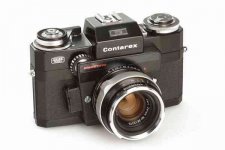Jason Schneider
the Camera Collector
The Most Technologically Advanced 35mm SLRs, Part 2, Section 1: The tumultuous ‘60s
The Most Technologically Advanced 35mm SLRs, Part 2, Section 1
The tumultuous ‘60s: Built-in TTL metering, autoexposure, and more!
By Jason Schneider
The 1960s marked the time when the 35mm SLR became the dominant camera type, surpassing the interchangeable lens rangefinder 35 and blowing the once mighty twin lens reflex into the weeds. It was also a time when built-in metering systems were becoming increasungly sophisticated, with TTL designs taking over and selenium cells being ecliped by battery powered CdS cells that were not only more sensutuive, but also had a narriwer acceptance angle, enabling accurate readings to be be made fron shooting position. Here are 10 stellar examples that tell the story of the second phase in the evolution oif the 35mm SLR and how it went from being a niche product to a mass market phenomenon that shaped today’s digital landscape.
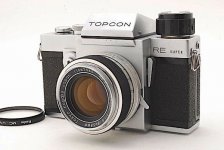
Topcon RE Super with 58mm f/1.8 RE Auto-Topcor and flash adapter: It pioneered built-in TTL metering with its CdS cell located behind slits in the mirror.
Topcon RE Super 1963. The first 35mm SLR with through-the-lens match-needle metering, it was manufactured by Tokyo Optical Company, Ltd. and initiated the basic trend that all other SLR makers were destined to follow. The RE Super was unique in having its CdS meter cell built into the mirror, permitting the use of simple interchangeable optical finders, but this system, designed in a joint project with Toshiba Electric Co., proved complex and expensive to produce. The RE was eclipsed on year later by the Pentax Spotmatic, which took TTL readings off the viewing screen, a simpler system adopted by virtually every other maker. Large, robust, and nicely finished, the Topcon RE Super features include; Interchangeable eye-level pentaprism and finder screens, single-stroke wind lever, full-aperture metering, cloth focal-plane shutter with speeds from 1-1/1000 sec plus B, winder/motor compatibility, and Exakta-compatible bayonet mount. Standard lens is the 58mm f/1.4 Auto Topcor. The RE Super was produced in four versions and provided the basis for the Topcon D-1 and Super DM that remained in production until the ‘80s. A clean original Topcon or Beseler Topcon RE Super with 50mmm f/1.4 lens sells for around $350-450.
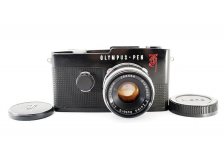
The Olympus Pen F, the first half-frame SLR, sired the Pen line, This is the rare and gorgeous black version with red Gothic F and 38mm f/1.8 F. Zuiko lens
Olympus Pen F 1963: The original Olympus Pen F (with gothic F on the front) of 1963-1966 was the first half-frame (18x24mm format) 35mm SLR designed specifically for this size (Alpa’s earlier half-frame model was a masked-down version of the standard 24x36mm-format Alpa.) Designed by a team lead by the legendary Y.Maitani, the Pen F arrived at the height of the half-frame craze begun by its stablemate, the scale-focusing Olympus Pen of 1959. Though meterless, it created a sensation. Innovative features include: An excellent line of bayonet-mount Zuiko interchangeable lenses (eventually ranging from 20mm to 800mm plus 2 zooms and a macro), a 2-stroke film-wind lever, a unique rotary-sector, metal focal-plane shutter (similar to the one in 24 x 24mm Robots from Germany) providing flash sync at all speeds from 1-1/500 sec, a horizontally-moving instant-return mirror, and a porroprism finder with bright full-focusing screen. An accessory coupled CdS meter prism bayoneted in place over the shutter-speed dial. With standard 38mm f/1.8 Zuiko lens the svelte Pen F measures only 5x2-3/4x 2-1/2 inches. The later Pen FT (1966-1972) has single-sroke wind, a built-in inconvenient transfer-the-setting metering system, anda somwhat dimmer viewfinder due to the light siphoned off for metering. The final Olympus Pen Fv of 1967-1970 is basically a meterless Pen FT with a brighter viewfinder and is widely regarded as the best if the lot. All are charming, well made user-collectibles. Prices fot clean, functionasl examples with 38mm f/1.8 Zuiko Auto-S lens range from $125-$250 for a pen F, $175-$320 for a Pen FT, amd $350-$450 for a Pen Fv. Rare black Pen Fs and FTs similarly equipped fetch $400 and up.
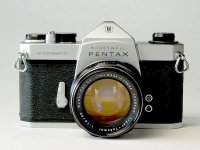
Pentax Spotmatic of 1964 (note Honeywell logo) and superb 50mm f/1.4 Super-Takumar lens. It was first in a long line of very popular M42 mount Pentaxes
Pentax Spotmatic 1964: The Spotmatic was the first though-the-lens- (TTL) metering 35mm SLR that took exposure readings off the finder screen, by means of two CdS cells placed on either side of the finder eyepiece. This brilliantly simple TTL-metering system was adopted by almost every other SLR manufacturer, and is still the dominant system in use today. The Pentax system, far less complicated and more flexible than Topcon’s clever mirror-mounted CdS meter cell (introduced a year earlier in the 1963 Topcon RE Super), has been refined to allow the sophisticated multipattern metering systems in current AF SLRs. In other respects, the Spotmatic (misnamed because it actually had a full-area averaging meter pattern) was quite conservative, providing match-needle metering at working aperture and using the traditional 42mm threaded lens mount pioneered by Praktica. Nevertheless it was a fairly compact, very attractive design and was one of the hottest-selling, most influential SLRs of its era. It was eventually developed into the similar-looking, full-aperture-metering Pentax Spotmatic F of 1974. Features include: Cloth focal-plane shutter with speeds from 1-1/1000 sec plus B, single-stroke wind lever, meter switch that strops down lens and doubles as an auto/manual diaphragm switch. The original Pentax Spotmatic and its similar variants, the Spotmatic SP and meterless SL are nice user-collectiblesand bargain priced at around $75-$150 with 55mm f/1.8 or 50mm f/1.4 Super-Takumar lens.
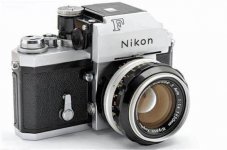
Nikon Phiotomic T with 50mm f/1.4 Nikon Auto-S: Its new prism bought TTL metering to the Nikon F, and it became the mainstay of pros and enthusiasts.
Nikon F Photomic T 1965: Introduced in 1965 to counter the 1963 Topcon RE Super’s technological coup of TTL metering, the Photomic T’s meter prism resembles the original prism but without the external CdS metering eye. Mounting the new prism with its larger eyepiece required a small modification to the top deck of earlier Nikon Fs. The system works by diverting a small amount of light from the eyepiece that then bounces around the pentaprism until it’s focused through a small condenser lens onto the CdS meter cell, providing full area averaging readings. This broad, unselective metering pattern can result in exposure errors, which is why Nikon brought forth the center-weighted Photomic Tn meter prism in 1966, which employs two aspheric condensers that provide center-weighted 60/40-percent readings. Both meter prisms used a pair of PX13 mercury batteries to power the CdS cells and must be modified to work properly with current 1.5v silver-oxide or alkaline cells. It took Nikon another 2 decades to fit a spot meter. The rest of the camera was just a minimally updated version on the classic Nikon F. A chrome Nikon Photomic T or Tn in clean functional condition with 50mm f/1.4 Nikkor lens will set you back about $150-$325 these days, which is something of a bargain. However, updating the meter prism to take currently available 1.5v batteries typically runs $50-75.
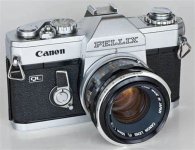
Canon Pellix with 50mm f/1.4 Canon FL lens: The first SLR with a non-flipping pellicle mirror it worked and was a technological tour de force, but it had issues.
Canon Pellix 1965: Canon unleashed the remarkable Pellix on an unsuspecting world in 1964, one year after launching its first “advanced amateur” 35mm SLR, the Canon FX that debuted the new FL mount. The Pellix also featured the expected TTL metering system, albeit employing stop-down metering system, but it embodied a revolutionary new concept in SLRs—a fixed semitransparent pellicle mirror placed behind the lens (hence the name Pellix) instead of the usual flip-up reflex mirror. The CdS metering cell is placed behind the pellicle mirror on an arm that swings up in front of the film gate when you press stop-down lever on the front of the camera. It provides match-needle readings based on the the light passing through the camera lens and through the pellicle mirror. The pellicle mirror in the Pellix, the first of its kind, allows about 2/3 of the light passing though the lens to reach the film, reflecting the rest uo into the viewfinder, As a result there is no mirror-induced vibration and no image blackout as the shutter fires.
Disadvanages of the system: the loss of about ½-stop of light used to make the exposure, slight degradation of the image by the pellicle mirror, reduced viewing brightness, and the potential for dust accumulation on the nirror, requiring delicate cleaning or mirror replacement. Canon brought out two fast FL lenses to compensate for the light loss, a 50mm f/1.4 and a 58mm f/1.2. In March 1966 Canon marketed the Canon Pellix QL , which had a quick-loading mechanism, and contacts in the base for an optional electronic booster for the internal metering system. Both models employ metal shutter curtains to prevent burning when the lens is exposed to brught sunlight, and there’s a finder blind ring under the rewind knob to prevent potential film fogging. Note: In 1995 Canon marketed the EOS-!N RS, an AF/AE SLR with a substantially improved pellicle mirror. Based on the EOS-1N, the EOS-1N RS has a fixed, semi-transparent pellicle mirror with a hard coat and at the time of its release it was the world’s fastest AF SLR camera with a continuous shooting speed of 10 fps. You can currently snag an original Canon Pellix or a Pellix QL in excellent cosmetic and operational condition with 50mm f/1.4 or f/1.8 FL lens for the staggeringly low price of $75-$125. They’re an acquired taste all right but nevertheless cool and collectible.
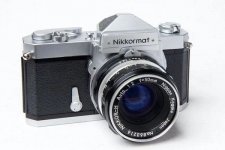
Nikkormat FTn with 50mm f/2 Nikkor-H lens: Advanced for its day it gave photo enthusiasts access to the huge Nikon system and was immensely popular.
Niknormat FTn 1965. This tweaked version of the Nikkormat FT, Nikon’s first TTL-metering SLR, no longer requires keying in the lens maximum aperture for external meter coupling—it was designed for AI (auto indexing) lenses that couple by turning the aperture ring back and forth from minimum to maximum aperture. Its metering system was also upgraded to provide Nikon’s classic 60/40 percent center-weighted readings, and +/- over/underexposure markers and a set shutter speed indication were added to the finder. This robust, metal bodied, manual, mechanical SLR became the mainstay of countless photo enthusiasts, vastly expanding Nikon’s marketing reach as well as spurring the sales of Nikkor lenses. Both models employed the metal-bladed, vertical travel Copal Square shutter with speeds of 1-1/1000 sec plus B, and flash sync at 1/125 sec, with the shutter speed ring concentric with the lens mount, provided match needle TTL metering at maximum aperture using CdS cells at the sides of the prism, and had Nikon’s the standard fixed focusing screen with 4mm central microprism and 12mm matte focusing area. There are two PC terminals, but no hot shoe—the accessory shoe was an accessory— but there was a mirror lockup and (on the FTn) a mechanical self-timer. Quite advanced for their time, the Nikkormat FT and FTn paved the way for the succeeding generation of broad-spectrum Nikon SLRs, the FM, FM2 and FM2n which remained on production until 2001. A Nikkormat FTn in nice shape with period 50mm f/2 Nikkor-H lens can be yours for a piddling $50-75.
Konica Auto Reflex 1966. This is really the first truly successful auto-exposure SLR in terms of its impact in the marketplace, and its mechanical reliability. (Technically, the 1959 Savoyflex III, a French SLR with a Prontor leaf shutter and selenium-cell-controlled, shutter-priority metering system takes first-of-its-kind laurels, but it was trouble prone and not widely distributed.). The Auto Reflex (known as the Autorex in Japan) features and external CdS cell to the right of the lens that controls a trap-needle type, shutter-priority autoexposure system, a feature or all Konica SLRs until the series finished in 1985. The Copal Square metal focal-plane shutter provides speeds of 1/25-1/400 sec in automatic mode and 1-1/1000 sec in manual match-needle-metering mode. Other features: fixed pentaprism, single stroke-wind lever, andmost remarkably the ability to switch between full (24x36mm) and half-frame (18x24mm) formats at any time! I can think of no other SLR that offers such flexibility!Less than two years later, the Auto Reflex evolved into the through-lens- (TTL) metering Autoreflex T, the camera that established Konica as a major SLR maker from the late ‘60s to the late ‘70s. Though it’s a historically important camera that’s not too common in this country, Konica Auto Reflexes are often reasonably priced when you find them, and they’ll accept all Konica bayonet-mount lenses. Approximate price with 57mm f/1.4 Konica Hexanon lens, $300.
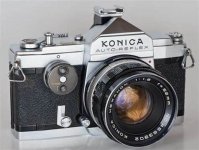
Konica Auto Reflex with 52mm f/1,8 Hexagon lens: The first successful autoexposure SLR, it also let you mix full and half frame images on the same roll!
Canon FT QL 1966. The second iteration of the Canon FT (the same camera sans the QL quick-loading feature), this was the camera that established Canon’s hugely successful Canon FL mount, compatible with a huge array of Canon lenses, and operable (in stop-down metering mode) with later Canon FD lenses. Aimed at a broad spectrum of shooters, the robust, crisply styled FT QL has an instant-return mirror, provides stop-down, semi-spot, CdS cell metering via a prism incorporated in the viewfinder condenser/screen assembly, but it has a fixed pentaprism and screens aren’t interchangeable. Other features: cloth focal plans shutter with speeds from 1-1/1000 sec plus B, flash sync at 1.60 sec, built-in mechanical self-timer, and a mirror lock that also enables the use of deeply set lenses liker the original 19mm f/3.5 ultra-wide Canon, albeit without reflex viewing. An accessory Canon Booster increased meter sensitivity by 16x, but it was clumsy and mostly used on a tripod. The long running (1966-1972) Canon FT QL was tweaked, with minor upgrades over the years, and it helped Canon compete with cameras like the Pentax Spotmatic. It was succeeded by the Canon FTb, which had an FD mount, full aperture metering, and other upgrades. You can snag a clean, functional Canon FT QL with 50mm f/1.8 Canon FL lens for a paltry $50-75, and for about a C-note with the excellent 50mm f/1.4 Canon FL lens.
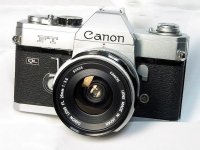
Canon FT QL with 28mm f/3.5 Canon FL lens: Along with its non-QL predecessor it established the Canon FT mount and attracted a broad spectrum of users.
Please go to Section 2 of this article for more info on technologically advanced landmark 35mm SLRs of the 1960s!
The Most Technologically Advanced 35mm SLRs, Part 2, Section 1
The tumultuous ‘60s: Built-in TTL metering, autoexposure, and more!
By Jason Schneider
The 1960s marked the time when the 35mm SLR became the dominant camera type, surpassing the interchangeable lens rangefinder 35 and blowing the once mighty twin lens reflex into the weeds. It was also a time when built-in metering systems were becoming increasungly sophisticated, with TTL designs taking over and selenium cells being ecliped by battery powered CdS cells that were not only more sensutuive, but also had a narriwer acceptance angle, enabling accurate readings to be be made fron shooting position. Here are 10 stellar examples that tell the story of the second phase in the evolution oif the 35mm SLR and how it went from being a niche product to a mass market phenomenon that shaped today’s digital landscape.

Topcon RE Super with 58mm f/1.8 RE Auto-Topcor and flash adapter: It pioneered built-in TTL metering with its CdS cell located behind slits in the mirror.
Topcon RE Super 1963. The first 35mm SLR with through-the-lens match-needle metering, it was manufactured by Tokyo Optical Company, Ltd. and initiated the basic trend that all other SLR makers were destined to follow. The RE Super was unique in having its CdS meter cell built into the mirror, permitting the use of simple interchangeable optical finders, but this system, designed in a joint project with Toshiba Electric Co., proved complex and expensive to produce. The RE was eclipsed on year later by the Pentax Spotmatic, which took TTL readings off the viewing screen, a simpler system adopted by virtually every other maker. Large, robust, and nicely finished, the Topcon RE Super features include; Interchangeable eye-level pentaprism and finder screens, single-stroke wind lever, full-aperture metering, cloth focal-plane shutter with speeds from 1-1/1000 sec plus B, winder/motor compatibility, and Exakta-compatible bayonet mount. Standard lens is the 58mm f/1.4 Auto Topcor. The RE Super was produced in four versions and provided the basis for the Topcon D-1 and Super DM that remained in production until the ‘80s. A clean original Topcon or Beseler Topcon RE Super with 50mmm f/1.4 lens sells for around $350-450.

The Olympus Pen F, the first half-frame SLR, sired the Pen line, This is the rare and gorgeous black version with red Gothic F and 38mm f/1.8 F. Zuiko lens
Olympus Pen F 1963: The original Olympus Pen F (with gothic F on the front) of 1963-1966 was the first half-frame (18x24mm format) 35mm SLR designed specifically for this size (Alpa’s earlier half-frame model was a masked-down version of the standard 24x36mm-format Alpa.) Designed by a team lead by the legendary Y.Maitani, the Pen F arrived at the height of the half-frame craze begun by its stablemate, the scale-focusing Olympus Pen of 1959. Though meterless, it created a sensation. Innovative features include: An excellent line of bayonet-mount Zuiko interchangeable lenses (eventually ranging from 20mm to 800mm plus 2 zooms and a macro), a 2-stroke film-wind lever, a unique rotary-sector, metal focal-plane shutter (similar to the one in 24 x 24mm Robots from Germany) providing flash sync at all speeds from 1-1/500 sec, a horizontally-moving instant-return mirror, and a porroprism finder with bright full-focusing screen. An accessory coupled CdS meter prism bayoneted in place over the shutter-speed dial. With standard 38mm f/1.8 Zuiko lens the svelte Pen F measures only 5x2-3/4x 2-1/2 inches. The later Pen FT (1966-1972) has single-sroke wind, a built-in inconvenient transfer-the-setting metering system, anda somwhat dimmer viewfinder due to the light siphoned off for metering. The final Olympus Pen Fv of 1967-1970 is basically a meterless Pen FT with a brighter viewfinder and is widely regarded as the best if the lot. All are charming, well made user-collectibles. Prices fot clean, functionasl examples with 38mm f/1.8 Zuiko Auto-S lens range from $125-$250 for a pen F, $175-$320 for a Pen FT, amd $350-$450 for a Pen Fv. Rare black Pen Fs and FTs similarly equipped fetch $400 and up.

Pentax Spotmatic of 1964 (note Honeywell logo) and superb 50mm f/1.4 Super-Takumar lens. It was first in a long line of very popular M42 mount Pentaxes
Pentax Spotmatic 1964: The Spotmatic was the first though-the-lens- (TTL) metering 35mm SLR that took exposure readings off the finder screen, by means of two CdS cells placed on either side of the finder eyepiece. This brilliantly simple TTL-metering system was adopted by almost every other SLR manufacturer, and is still the dominant system in use today. The Pentax system, far less complicated and more flexible than Topcon’s clever mirror-mounted CdS meter cell (introduced a year earlier in the 1963 Topcon RE Super), has been refined to allow the sophisticated multipattern metering systems in current AF SLRs. In other respects, the Spotmatic (misnamed because it actually had a full-area averaging meter pattern) was quite conservative, providing match-needle metering at working aperture and using the traditional 42mm threaded lens mount pioneered by Praktica. Nevertheless it was a fairly compact, very attractive design and was one of the hottest-selling, most influential SLRs of its era. It was eventually developed into the similar-looking, full-aperture-metering Pentax Spotmatic F of 1974. Features include: Cloth focal-plane shutter with speeds from 1-1/1000 sec plus B, single-stroke wind lever, meter switch that strops down lens and doubles as an auto/manual diaphragm switch. The original Pentax Spotmatic and its similar variants, the Spotmatic SP and meterless SL are nice user-collectiblesand bargain priced at around $75-$150 with 55mm f/1.8 or 50mm f/1.4 Super-Takumar lens.

Nikon Phiotomic T with 50mm f/1.4 Nikon Auto-S: Its new prism bought TTL metering to the Nikon F, and it became the mainstay of pros and enthusiasts.
Nikon F Photomic T 1965: Introduced in 1965 to counter the 1963 Topcon RE Super’s technological coup of TTL metering, the Photomic T’s meter prism resembles the original prism but without the external CdS metering eye. Mounting the new prism with its larger eyepiece required a small modification to the top deck of earlier Nikon Fs. The system works by diverting a small amount of light from the eyepiece that then bounces around the pentaprism until it’s focused through a small condenser lens onto the CdS meter cell, providing full area averaging readings. This broad, unselective metering pattern can result in exposure errors, which is why Nikon brought forth the center-weighted Photomic Tn meter prism in 1966, which employs two aspheric condensers that provide center-weighted 60/40-percent readings. Both meter prisms used a pair of PX13 mercury batteries to power the CdS cells and must be modified to work properly with current 1.5v silver-oxide or alkaline cells. It took Nikon another 2 decades to fit a spot meter. The rest of the camera was just a minimally updated version on the classic Nikon F. A chrome Nikon Photomic T or Tn in clean functional condition with 50mm f/1.4 Nikkor lens will set you back about $150-$325 these days, which is something of a bargain. However, updating the meter prism to take currently available 1.5v batteries typically runs $50-75.

Canon Pellix with 50mm f/1.4 Canon FL lens: The first SLR with a non-flipping pellicle mirror it worked and was a technological tour de force, but it had issues.
Canon Pellix 1965: Canon unleashed the remarkable Pellix on an unsuspecting world in 1964, one year after launching its first “advanced amateur” 35mm SLR, the Canon FX that debuted the new FL mount. The Pellix also featured the expected TTL metering system, albeit employing stop-down metering system, but it embodied a revolutionary new concept in SLRs—a fixed semitransparent pellicle mirror placed behind the lens (hence the name Pellix) instead of the usual flip-up reflex mirror. The CdS metering cell is placed behind the pellicle mirror on an arm that swings up in front of the film gate when you press stop-down lever on the front of the camera. It provides match-needle readings based on the the light passing through the camera lens and through the pellicle mirror. The pellicle mirror in the Pellix, the first of its kind, allows about 2/3 of the light passing though the lens to reach the film, reflecting the rest uo into the viewfinder, As a result there is no mirror-induced vibration and no image blackout as the shutter fires.
Disadvanages of the system: the loss of about ½-stop of light used to make the exposure, slight degradation of the image by the pellicle mirror, reduced viewing brightness, and the potential for dust accumulation on the nirror, requiring delicate cleaning or mirror replacement. Canon brought out two fast FL lenses to compensate for the light loss, a 50mm f/1.4 and a 58mm f/1.2. In March 1966 Canon marketed the Canon Pellix QL , which had a quick-loading mechanism, and contacts in the base for an optional electronic booster for the internal metering system. Both models employ metal shutter curtains to prevent burning when the lens is exposed to brught sunlight, and there’s a finder blind ring under the rewind knob to prevent potential film fogging. Note: In 1995 Canon marketed the EOS-!N RS, an AF/AE SLR with a substantially improved pellicle mirror. Based on the EOS-1N, the EOS-1N RS has a fixed, semi-transparent pellicle mirror with a hard coat and at the time of its release it was the world’s fastest AF SLR camera with a continuous shooting speed of 10 fps. You can currently snag an original Canon Pellix or a Pellix QL in excellent cosmetic and operational condition with 50mm f/1.4 or f/1.8 FL lens for the staggeringly low price of $75-$125. They’re an acquired taste all right but nevertheless cool and collectible.

Nikkormat FTn with 50mm f/2 Nikkor-H lens: Advanced for its day it gave photo enthusiasts access to the huge Nikon system and was immensely popular.
Niknormat FTn 1965. This tweaked version of the Nikkormat FT, Nikon’s first TTL-metering SLR, no longer requires keying in the lens maximum aperture for external meter coupling—it was designed for AI (auto indexing) lenses that couple by turning the aperture ring back and forth from minimum to maximum aperture. Its metering system was also upgraded to provide Nikon’s classic 60/40 percent center-weighted readings, and +/- over/underexposure markers and a set shutter speed indication were added to the finder. This robust, metal bodied, manual, mechanical SLR became the mainstay of countless photo enthusiasts, vastly expanding Nikon’s marketing reach as well as spurring the sales of Nikkor lenses. Both models employed the metal-bladed, vertical travel Copal Square shutter with speeds of 1-1/1000 sec plus B, and flash sync at 1/125 sec, with the shutter speed ring concentric with the lens mount, provided match needle TTL metering at maximum aperture using CdS cells at the sides of the prism, and had Nikon’s the standard fixed focusing screen with 4mm central microprism and 12mm matte focusing area. There are two PC terminals, but no hot shoe—the accessory shoe was an accessory— but there was a mirror lockup and (on the FTn) a mechanical self-timer. Quite advanced for their time, the Nikkormat FT and FTn paved the way for the succeeding generation of broad-spectrum Nikon SLRs, the FM, FM2 and FM2n which remained on production until 2001. A Nikkormat FTn in nice shape with period 50mm f/2 Nikkor-H lens can be yours for a piddling $50-75.
Konica Auto Reflex 1966. This is really the first truly successful auto-exposure SLR in terms of its impact in the marketplace, and its mechanical reliability. (Technically, the 1959 Savoyflex III, a French SLR with a Prontor leaf shutter and selenium-cell-controlled, shutter-priority metering system takes first-of-its-kind laurels, but it was trouble prone and not widely distributed.). The Auto Reflex (known as the Autorex in Japan) features and external CdS cell to the right of the lens that controls a trap-needle type, shutter-priority autoexposure system, a feature or all Konica SLRs until the series finished in 1985. The Copal Square metal focal-plane shutter provides speeds of 1/25-1/400 sec in automatic mode and 1-1/1000 sec in manual match-needle-metering mode. Other features: fixed pentaprism, single stroke-wind lever, andmost remarkably the ability to switch between full (24x36mm) and half-frame (18x24mm) formats at any time! I can think of no other SLR that offers such flexibility!Less than two years later, the Auto Reflex evolved into the through-lens- (TTL) metering Autoreflex T, the camera that established Konica as a major SLR maker from the late ‘60s to the late ‘70s. Though it’s a historically important camera that’s not too common in this country, Konica Auto Reflexes are often reasonably priced when you find them, and they’ll accept all Konica bayonet-mount lenses. Approximate price with 57mm f/1.4 Konica Hexanon lens, $300.

Konica Auto Reflex with 52mm f/1,8 Hexagon lens: The first successful autoexposure SLR, it also let you mix full and half frame images on the same roll!
Canon FT QL 1966. The second iteration of the Canon FT (the same camera sans the QL quick-loading feature), this was the camera that established Canon’s hugely successful Canon FL mount, compatible with a huge array of Canon lenses, and operable (in stop-down metering mode) with later Canon FD lenses. Aimed at a broad spectrum of shooters, the robust, crisply styled FT QL has an instant-return mirror, provides stop-down, semi-spot, CdS cell metering via a prism incorporated in the viewfinder condenser/screen assembly, but it has a fixed pentaprism and screens aren’t interchangeable. Other features: cloth focal plans shutter with speeds from 1-1/1000 sec plus B, flash sync at 1.60 sec, built-in mechanical self-timer, and a mirror lock that also enables the use of deeply set lenses liker the original 19mm f/3.5 ultra-wide Canon, albeit without reflex viewing. An accessory Canon Booster increased meter sensitivity by 16x, but it was clumsy and mostly used on a tripod. The long running (1966-1972) Canon FT QL was tweaked, with minor upgrades over the years, and it helped Canon compete with cameras like the Pentax Spotmatic. It was succeeded by the Canon FTb, which had an FD mount, full aperture metering, and other upgrades. You can snag a clean, functional Canon FT QL with 50mm f/1.8 Canon FL lens for a paltry $50-75, and for about a C-note with the excellent 50mm f/1.4 Canon FL lens.

Canon FT QL with 28mm f/3.5 Canon FL lens: Along with its non-QL predecessor it established the Canon FT mount and attracted a broad spectrum of users.
Please go to Section 2 of this article for more info on technologically advanced landmark 35mm SLRs of the 1960s!
Jason Schneider
the Camera Collector
Most Technologically Advanced 35mm SLRs, Part 2, Section 2: Seven more from the tumultuous 60s.
Miranda Sensorex 1966. Produced in 7 distinct model variations from 1966-1972, the Sensorex offered a full array of pro-oriented features designed to compete with Nikon and Topcon, but at a much lower price to appeal to enthusiasts as well as pros. The flagship of the Miranda line, the Sensorex has an interchangeable pentaprism finder, fully automatic diaphragm lenses, an in-body TTL metering system with behind-mirror CdS metering system that provides bottom-center-weighted (fat spot) match-needle readings at full aperture, and dedicated diaphragm setting and DOF preview levers. Other key features: dual Miranda bayonet mount with internal screw thread, instant-return mirror, non-interchangeable viewing screen with central “multi-microprism” area (said to be the first in any SLR), cloth focal plane shutter with speeds of 1-1/1000 plus B and flash sync at 1/60 sec, ASA settings 25-1600, and (on the first model) a detachable back cover. The meter was designed for 1.35v mercury cells and must be modified to accept current 1.5v silver-oxide or alkaline cells. Standard lens is the excellent 50mm f/1.9 Auto Miranda with no click stops and apertures to f/16, but there was also a superb 8-element 50mm f/1.4 version available that was changed to a 7-element, 5-group design on subsequent models. The Miranda Sensorex is a hefty, well-designed camera complemented by an array of excellent lenses, and it’s capable of creditable on-film performance.However, it was plagued by reliability and quality control problems, never seriously challenged its archrivals, and suffered from declining sales before the factory was shuttered in 1978. Clean working examples of the original Sensorex and the mildly tweaked Sensorex II (identifiable by its plain front prism cover) are readily available with lens for a paltry $50-150, but make sure yours comes with full return privileges!
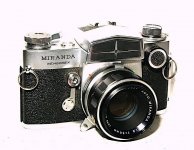
Miranda Sensorex with 50mm f/1.8 Auto Miranda lens: An ingenious modular system SLR designed to compete with Nikon et al it fell short on quality control.
Minolta SR-T 101 1967. The first Minolta 35mm SLR with through-the-lens metering, the best-selling SR-T 101 really put Minolta in contention as one of the big four SLR makers and influenced the design of Minolta SLRs for a decade. It was also the first to incorporate Contrast-Light-Compensating (CLC) metering, a two-zone metering system that compensates for unusual lighting contrasts, and is a forerunner of modern multi-pattern systems used today. Other features: match-needle metering at full aperture via two prism-mounted CdS cells, cloth focal-plane shutter with speeds from 1 to 1/1000 sec plus B, X-sync at 1/60 sec, fixed eye-level pentaprism with non-interchangeable full focusing screen with microprism spot and groundglass collar, self-timer, and a depth-of-field preview. Normal lenses include the 58mm f/1.4 and 55mm f/1.7 MC Rokkors. The Minolta SR-T series are wonderfully styled cameras, convenient to use, and often underappreciated. An extensive range of lenses and accessories were available. An enduring design, the SR-T 101is considered a classic user-collectible. Clean, working examples sell in the $150-250 range.
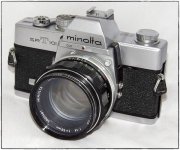
Minolta SR-T 101 with early and collectible 58mm f/1.4 Rokkor lens: A solid, reliable machine it was Minolta's most popular manual focus SLR of all time.
Konica Autoreflex T 1968. The Autoreflex T was the first 35mm SLR in the world with through-the-lens (TTL) fully automatic exposure control. Like the landmark Konica Auto Reflex of 1966 (the first widely distributed auto-exposure SLR) it features shutter-priority auto-exposure based on a mechanical trap-needle system (a substantially refined version of the system used in the Kodak Super Six 20 roll film camera of 1938). The Autoreflex T is a handsome and reliable machine that was very successful in the marketplace, and for a time, made Konica a leading contender in the 35mm SLR sector. It also encouraged other makers, notably Canon, Nikon, Minolta, and Pentax, to develop auto-exposure SLRs, thereby vastly expanding the overall SLR market. Other features: metal Copal Square shutter with speeds from 1-1/000 sec plus B, fixed eye-level pentaprism with CdS cells reading off focusing screen, single-stroke wind lever, and Konica bayonet mount. Konica SLRs using the same basic auto-exposure system remained in production until the motorized FT-1 of 1983 and the simplified TC-X of 1985. The Autoreflex T is a historically significant, moderately priced user-collectible that sells in the $150-200 range with 57mm f/1.4 or 50mm f/1.7 Hexanon lens. Konica lenses were among the best made in Japan.
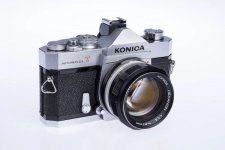
Konica Autoreflex T with the coveted 57mm f/1.4 Hexanon lens: The first SLR with TTL autoexposure, it catapaulted Konica into the top tier of SLR makers.
Kodak Instamatic Reflex 1968. Made in Germany by Kodak AG this top-of-the-line Instamatic was a sophisticated interchangeable lens SLR with a non-TTL aperture priority metering system controlled by an external CdS meter port. It employed a Compur Electronic leaf shutter providing speeds of 20-1/500 sec with flash sync (for top-mounted Flash Cubes!) at 1/30 sec, provided automatic film speed setting with 126 Instamatic cartridges ranging from ASA 64 to 160, and had a DKL lens mount compatible with existing Retina and Retina Reflex lenses from 28-200mm. Other features: fixed viewfinder screen with split-image rangefinder, diecast aluminum body, PC socket for an accessory flash gun, and a battery tester for its two PX825 batteries. Standard lenses were a 50mm f/1.9 Schneider Xenon and a 45mm f/2.8 Schneider Xenar, and the camera was made in chrome and black finishes. While Kodak 126 cartridges had film flatness issues, the Kodak Instamatic Reflex was capable of impressive imaging performance according to most reviewers. It’s certainly a unique and fascinating collectible, but it’s now a filmless classic because 126 cartridges are kaput. Or, in the immortal words of Wikipedia, “Unused, outdated 126 films continue to show up at thrift stores, estate sales, and online auctions. But unless they have been stored frozen, they’re probably deteriorated and are suitable only for experimenting.” If you’re still game, you can acquire a nice clean chrome example with 45mm f/2.8 Xenar lens for around $50-60.
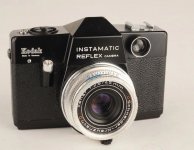
Kodal Instamatic Reflex in black with interchangeable 45mm f/2.8 Schneider Xenar lens. Made in Germany, it performed well but it's now a fiimless classic
Mamiya/Sekor 1000 DTL 1968: Mamiya offered a series of competent M-42 screw mount SLRs in the latter half of the ‘60s incorporating spot metering, but the DTL 1000 of 1968-1974 was the most technically impressive, being the first TTL-metering SLR to offer two metering modes, plus other “high-end” features like wide-open-aperture metering. A switch next to the lens mount allowed photographer to select a full-are averaging meter pattern or “spot,” covering a square central area toward the bottom of the frame. The mode selected is indicated by brackets in the finder. Inside the brackets is an S for spot metering, and just outside them is an A for averaging. A small triangular flag points to the selected mode so the photographer doesn’t have to touch the switch to know which one is activated. The concept was protected by U.S. Patent No. 3.612,703 filed on 29 February 1968. The 1000 DTL features a fixed pentaprism, microprism-spot screen, match-needle meter indication in the finder, a horizontal cloth focal-plane shutter with speeds of 1-1/000 sec plus B and X-sync at 1/60 sec, a ratcheted single-stroke wind lever, and mechanical self-timer. The meter is powered by one readily available 1.5v battery. In addition to the 1000 DTL, Mamiya introduced an economy model 500 DTL with a top shutter speed of 1/500 sec, and the 2000 DTL with a top shutter speed of 1/2000 sec. Despite its technological bona fides the Mamiya/Sekor 1000 DTL is not avidly collected, and you can pick up a clean, functional example complete with 55mm f/1,4 or f/1.8 Mamiya/Sekor lens for around 50 bucks or even less—not at all bad for a good user SLR! However, Its less than reliable mechanics might have something to do with the low prices.
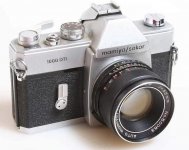
Mamiya/Sekor 1000 DTL with 55mm f/1.8 Mamiya/Sekor lens: The first 35mm SLR with a choice of 2 metering modes, it had good lenses but reliability was so-so.
Leicaflex SL 1968: Four years after delivering the defiantly old school original Leicaflex (now known as the Leicaflex Standard) with its separate CdS meter eye and a center-circle-only focusing screen with aerial image outer area, they finally gave us the camera many Leica fans had been clamoring for, the Leicaflex SL (the letters stand for selective light metering). The camera provides TTL readings, measuring the central 5% of the subject field, a semi-spot area corresponding to the central microprism circle. This ingenious system works by diverting about 20% of the light passing through the lens to a special, slightly cylindrical mirror hinged behind the main instant return mirror, which reflects the light onto a CdS double-resistor photocell. During the exposure the special “piggyback” mirror folds flush against the main mirror, preventing stray light from entering via the eyepiece and affecting the readings. Brilliant! Other features such as the 1-1/2000 plus B focal plane shutter, top mounted single-stroke wind lever and large non-rotating shutter dial placed concentrically around the shutter release closely parallel those of the Standard. However, the SL’s uniformly bright focusing screen has a central split image rangefinder surrounded by a microprism collar, a bottom-mounted battery compartment, a depth of field preview button, a set shutter speed scale along the bottom of the finder with the meter needle and match needle follow pointer on the right. Leicaflex R-mount lenses without coupling cams designed for the Leicaflex Standard are useable on the SL, albeit without metering, but later 2-. And 3-cam R lenses are backward compatible and work on the SL. In 1974 the Leicaflex SL was succeeded by the SL2, which had a 3-stops greater meter sensitivity, and added an aperture indicator in the finder. It also had a redesigned mirror to accommodate new wider-angle 16mm and 19mm lenses, and a battery powered finder info illumination system to facilitate shooting in low light. A motorized version, the SL MOT with ponderous removable electric motor drive, was made from 1972-1975 and according to Leica-Wiki a total of 1,080 were produced. A grand total of 74,818 Leicaflex SLs were turned out between 1968 and 1975 including a small number of 50[SUP]th[/SUP] Anniversary and other commemorative models. The SL is beautifully made and durable, will require an upgrade to work properly with modern 1.5v batteries, and is a superb picture taker. Some say it’s a bit better made than the SL2, but both are among the finest 35mm SLRs ever in terms of sheer build quality. A pristine example with 50mm f/2 Summicron-R lens in black or chrome will set you back about $600-$800; an SL2 body only is about the same.
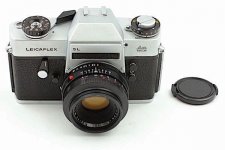
Leicaflex SL with 50mm f/2 Summicron-R lens: With its sophisticated TTL metering, many upgrades, and superb mechanics, it may be the best Leicaflex ever.
Contarex SE 1968. The final iteration of the Contarex and technically the most advanced, the SE is based on the TTL-metering Contarex S but its 1-1/1000 sec plus B focal plane shutter is electronically controlled, it has a crisp contemporary form factor, and it’s compatible with some ultra-cool electronic accessories. These include an electronic pulse generator for shooting bursts, a remote-control release, and a connector for remote triggering by microphone, photocell, or another pulse generator. Most fascinating is a photoelectric “tele-sensor” providing fully automatic control of infinitely variable shutter speeds from 8-1/.1000 sec to match the pre-set aperture, a very early example pf electronically controlled aperture priority automation! Finally, there’s a motor drive that can shoot bursts at about 2 fps. The SE’s metering system employs a small parabolic mirror on the rear of the main mirror that reflects the light passing through a partially silvered spot on the main mirror down to a tiny CdS cell at the bottom of the mirror box. The cell measures about 7% of the total image area providing semi-spot readings down to f/1.4 at 1/15 sec at ASA 100 and both apertures and shutter speeds are shown in the finder. The camera also has a mirror lockup, a top mounted hot shoe, and a locking PC terminal, but it’s also beset with such retrograde features as a manually set frame counter, a non-removable prism, a lift-and-set shutter speed dial (said to be corrected on late models), and lenses that reopen to maximum aperture only when the film is wound. The Contarex SE, despite its advanced electronics, remains a unique example of superb mechanical workmanship and awesome imaging capability thanks to its exquisite line of Zeiss lenses, but it’s also staggeringly complex, massive in size and heft, and beset with some not so endearing quirks. It’s also quite expensive, about $1,500-$2,000 with 50mm f/2 Planar lens, and it's a bear to get repaired. Despite everything, I’d love to own one but due to “financial constraints” it will remain on my unfulfilled wish list.
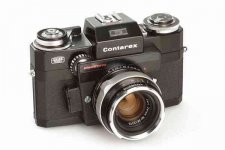
Contarex SE electronic: The last and most technically advanced Contarex, its shutter is electronically controlled and it integrates with an incredible array of electronic accessories that provide, among other things, stemless aperture-priority autoexposure! Regrettably that wasn't enough to endear it to pros and it never really caught on.
Miranda Sensorex 1966. Produced in 7 distinct model variations from 1966-1972, the Sensorex offered a full array of pro-oriented features designed to compete with Nikon and Topcon, but at a much lower price to appeal to enthusiasts as well as pros. The flagship of the Miranda line, the Sensorex has an interchangeable pentaprism finder, fully automatic diaphragm lenses, an in-body TTL metering system with behind-mirror CdS metering system that provides bottom-center-weighted (fat spot) match-needle readings at full aperture, and dedicated diaphragm setting and DOF preview levers. Other key features: dual Miranda bayonet mount with internal screw thread, instant-return mirror, non-interchangeable viewing screen with central “multi-microprism” area (said to be the first in any SLR), cloth focal plane shutter with speeds of 1-1/1000 plus B and flash sync at 1/60 sec, ASA settings 25-1600, and (on the first model) a detachable back cover. The meter was designed for 1.35v mercury cells and must be modified to accept current 1.5v silver-oxide or alkaline cells. Standard lens is the excellent 50mm f/1.9 Auto Miranda with no click stops and apertures to f/16, but there was also a superb 8-element 50mm f/1.4 version available that was changed to a 7-element, 5-group design on subsequent models. The Miranda Sensorex is a hefty, well-designed camera complemented by an array of excellent lenses, and it’s capable of creditable on-film performance.However, it was plagued by reliability and quality control problems, never seriously challenged its archrivals, and suffered from declining sales before the factory was shuttered in 1978. Clean working examples of the original Sensorex and the mildly tweaked Sensorex II (identifiable by its plain front prism cover) are readily available with lens for a paltry $50-150, but make sure yours comes with full return privileges!

Miranda Sensorex with 50mm f/1.8 Auto Miranda lens: An ingenious modular system SLR designed to compete with Nikon et al it fell short on quality control.
Minolta SR-T 101 1967. The first Minolta 35mm SLR with through-the-lens metering, the best-selling SR-T 101 really put Minolta in contention as one of the big four SLR makers and influenced the design of Minolta SLRs for a decade. It was also the first to incorporate Contrast-Light-Compensating (CLC) metering, a two-zone metering system that compensates for unusual lighting contrasts, and is a forerunner of modern multi-pattern systems used today. Other features: match-needle metering at full aperture via two prism-mounted CdS cells, cloth focal-plane shutter with speeds from 1 to 1/1000 sec plus B, X-sync at 1/60 sec, fixed eye-level pentaprism with non-interchangeable full focusing screen with microprism spot and groundglass collar, self-timer, and a depth-of-field preview. Normal lenses include the 58mm f/1.4 and 55mm f/1.7 MC Rokkors. The Minolta SR-T series are wonderfully styled cameras, convenient to use, and often underappreciated. An extensive range of lenses and accessories were available. An enduring design, the SR-T 101is considered a classic user-collectible. Clean, working examples sell in the $150-250 range.

Minolta SR-T 101 with early and collectible 58mm f/1.4 Rokkor lens: A solid, reliable machine it was Minolta's most popular manual focus SLR of all time.
Konica Autoreflex T 1968. The Autoreflex T was the first 35mm SLR in the world with through-the-lens (TTL) fully automatic exposure control. Like the landmark Konica Auto Reflex of 1966 (the first widely distributed auto-exposure SLR) it features shutter-priority auto-exposure based on a mechanical trap-needle system (a substantially refined version of the system used in the Kodak Super Six 20 roll film camera of 1938). The Autoreflex T is a handsome and reliable machine that was very successful in the marketplace, and for a time, made Konica a leading contender in the 35mm SLR sector. It also encouraged other makers, notably Canon, Nikon, Minolta, and Pentax, to develop auto-exposure SLRs, thereby vastly expanding the overall SLR market. Other features: metal Copal Square shutter with speeds from 1-1/000 sec plus B, fixed eye-level pentaprism with CdS cells reading off focusing screen, single-stroke wind lever, and Konica bayonet mount. Konica SLRs using the same basic auto-exposure system remained in production until the motorized FT-1 of 1983 and the simplified TC-X of 1985. The Autoreflex T is a historically significant, moderately priced user-collectible that sells in the $150-200 range with 57mm f/1.4 or 50mm f/1.7 Hexanon lens. Konica lenses were among the best made in Japan.

Konica Autoreflex T with the coveted 57mm f/1.4 Hexanon lens: The first SLR with TTL autoexposure, it catapaulted Konica into the top tier of SLR makers.
Kodak Instamatic Reflex 1968. Made in Germany by Kodak AG this top-of-the-line Instamatic was a sophisticated interchangeable lens SLR with a non-TTL aperture priority metering system controlled by an external CdS meter port. It employed a Compur Electronic leaf shutter providing speeds of 20-1/500 sec with flash sync (for top-mounted Flash Cubes!) at 1/30 sec, provided automatic film speed setting with 126 Instamatic cartridges ranging from ASA 64 to 160, and had a DKL lens mount compatible with existing Retina and Retina Reflex lenses from 28-200mm. Other features: fixed viewfinder screen with split-image rangefinder, diecast aluminum body, PC socket for an accessory flash gun, and a battery tester for its two PX825 batteries. Standard lenses were a 50mm f/1.9 Schneider Xenon and a 45mm f/2.8 Schneider Xenar, and the camera was made in chrome and black finishes. While Kodak 126 cartridges had film flatness issues, the Kodak Instamatic Reflex was capable of impressive imaging performance according to most reviewers. It’s certainly a unique and fascinating collectible, but it’s now a filmless classic because 126 cartridges are kaput. Or, in the immortal words of Wikipedia, “Unused, outdated 126 films continue to show up at thrift stores, estate sales, and online auctions. But unless they have been stored frozen, they’re probably deteriorated and are suitable only for experimenting.” If you’re still game, you can acquire a nice clean chrome example with 45mm f/2.8 Xenar lens for around $50-60.

Kodal Instamatic Reflex in black with interchangeable 45mm f/2.8 Schneider Xenar lens. Made in Germany, it performed well but it's now a fiimless classic
Mamiya/Sekor 1000 DTL 1968: Mamiya offered a series of competent M-42 screw mount SLRs in the latter half of the ‘60s incorporating spot metering, but the DTL 1000 of 1968-1974 was the most technically impressive, being the first TTL-metering SLR to offer two metering modes, plus other “high-end” features like wide-open-aperture metering. A switch next to the lens mount allowed photographer to select a full-are averaging meter pattern or “spot,” covering a square central area toward the bottom of the frame. The mode selected is indicated by brackets in the finder. Inside the brackets is an S for spot metering, and just outside them is an A for averaging. A small triangular flag points to the selected mode so the photographer doesn’t have to touch the switch to know which one is activated. The concept was protected by U.S. Patent No. 3.612,703 filed on 29 February 1968. The 1000 DTL features a fixed pentaprism, microprism-spot screen, match-needle meter indication in the finder, a horizontal cloth focal-plane shutter with speeds of 1-1/000 sec plus B and X-sync at 1/60 sec, a ratcheted single-stroke wind lever, and mechanical self-timer. The meter is powered by one readily available 1.5v battery. In addition to the 1000 DTL, Mamiya introduced an economy model 500 DTL with a top shutter speed of 1/500 sec, and the 2000 DTL with a top shutter speed of 1/2000 sec. Despite its technological bona fides the Mamiya/Sekor 1000 DTL is not avidly collected, and you can pick up a clean, functional example complete with 55mm f/1,4 or f/1.8 Mamiya/Sekor lens for around 50 bucks or even less—not at all bad for a good user SLR! However, Its less than reliable mechanics might have something to do with the low prices.

Mamiya/Sekor 1000 DTL with 55mm f/1.8 Mamiya/Sekor lens: The first 35mm SLR with a choice of 2 metering modes, it had good lenses but reliability was so-so.
Leicaflex SL 1968: Four years after delivering the defiantly old school original Leicaflex (now known as the Leicaflex Standard) with its separate CdS meter eye and a center-circle-only focusing screen with aerial image outer area, they finally gave us the camera many Leica fans had been clamoring for, the Leicaflex SL (the letters stand for selective light metering). The camera provides TTL readings, measuring the central 5% of the subject field, a semi-spot area corresponding to the central microprism circle. This ingenious system works by diverting about 20% of the light passing through the lens to a special, slightly cylindrical mirror hinged behind the main instant return mirror, which reflects the light onto a CdS double-resistor photocell. During the exposure the special “piggyback” mirror folds flush against the main mirror, preventing stray light from entering via the eyepiece and affecting the readings. Brilliant! Other features such as the 1-1/2000 plus B focal plane shutter, top mounted single-stroke wind lever and large non-rotating shutter dial placed concentrically around the shutter release closely parallel those of the Standard. However, the SL’s uniformly bright focusing screen has a central split image rangefinder surrounded by a microprism collar, a bottom-mounted battery compartment, a depth of field preview button, a set shutter speed scale along the bottom of the finder with the meter needle and match needle follow pointer on the right. Leicaflex R-mount lenses without coupling cams designed for the Leicaflex Standard are useable on the SL, albeit without metering, but later 2-. And 3-cam R lenses are backward compatible and work on the SL. In 1974 the Leicaflex SL was succeeded by the SL2, which had a 3-stops greater meter sensitivity, and added an aperture indicator in the finder. It also had a redesigned mirror to accommodate new wider-angle 16mm and 19mm lenses, and a battery powered finder info illumination system to facilitate shooting in low light. A motorized version, the SL MOT with ponderous removable electric motor drive, was made from 1972-1975 and according to Leica-Wiki a total of 1,080 were produced. A grand total of 74,818 Leicaflex SLs were turned out between 1968 and 1975 including a small number of 50[SUP]th[/SUP] Anniversary and other commemorative models. The SL is beautifully made and durable, will require an upgrade to work properly with modern 1.5v batteries, and is a superb picture taker. Some say it’s a bit better made than the SL2, but both are among the finest 35mm SLRs ever in terms of sheer build quality. A pristine example with 50mm f/2 Summicron-R lens in black or chrome will set you back about $600-$800; an SL2 body only is about the same.

Leicaflex SL with 50mm f/2 Summicron-R lens: With its sophisticated TTL metering, many upgrades, and superb mechanics, it may be the best Leicaflex ever.
Contarex SE 1968. The final iteration of the Contarex and technically the most advanced, the SE is based on the TTL-metering Contarex S but its 1-1/1000 sec plus B focal plane shutter is electronically controlled, it has a crisp contemporary form factor, and it’s compatible with some ultra-cool electronic accessories. These include an electronic pulse generator for shooting bursts, a remote-control release, and a connector for remote triggering by microphone, photocell, or another pulse generator. Most fascinating is a photoelectric “tele-sensor” providing fully automatic control of infinitely variable shutter speeds from 8-1/.1000 sec to match the pre-set aperture, a very early example pf electronically controlled aperture priority automation! Finally, there’s a motor drive that can shoot bursts at about 2 fps. The SE’s metering system employs a small parabolic mirror on the rear of the main mirror that reflects the light passing through a partially silvered spot on the main mirror down to a tiny CdS cell at the bottom of the mirror box. The cell measures about 7% of the total image area providing semi-spot readings down to f/1.4 at 1/15 sec at ASA 100 and both apertures and shutter speeds are shown in the finder. The camera also has a mirror lockup, a top mounted hot shoe, and a locking PC terminal, but it’s also beset with such retrograde features as a manually set frame counter, a non-removable prism, a lift-and-set shutter speed dial (said to be corrected on late models), and lenses that reopen to maximum aperture only when the film is wound. The Contarex SE, despite its advanced electronics, remains a unique example of superb mechanical workmanship and awesome imaging capability thanks to its exquisite line of Zeiss lenses, but it’s also staggeringly complex, massive in size and heft, and beset with some not so endearing quirks. It’s also quite expensive, about $1,500-$2,000 with 50mm f/2 Planar lens, and it's a bear to get repaired. Despite everything, I’d love to own one but due to “financial constraints” it will remain on my unfulfilled wish list.

Contarex SE electronic: The last and most technically advanced Contarex, its shutter is electronically controlled and it integrates with an incredible array of electronic accessories that provide, among other things, stemless aperture-priority autoexposure! Regrettably that wasn't enough to endear it to pros and it never really caught on.
Attachments
johnf04
Well-known
The Praktica LLC, produced from late 1969 to 1975, was the first SLR with electrical aperture simulation, to allow full open metering with only the stopdown connection to the lens.
p.giannakis
Pan Giannakis
As always, brilliant article, I love reading these. Thank you for all the effort that you put in these articles.
farlymac
PF McFarland
Some more great reporting, Jason. As for the Nikkormat FTn, that was my choice back in the day when it took a whole month of my Navy salary to purchase one with the 50/1.4. But it was well worth it, even if it meant only eating at the ship's galley for the next 30 days.
PF
PF
Retro-Grouch
Well-known
As always, brilliant article, I love reading these. Thank you for all the effort that you put in these articles.
I second these sentiments! I remember drooling over these cameras as a teenager, when Modern Photography did its yearly camera reviews. These articles truly are a blast from the past. Thank you, Jason!
Pál_K
Cameras. I has it.
I second these sentiments! I remember drooling over these cameras as a teenager, when Modern Photography did its yearly camera reviews. These articles truly are a blast from the past. Thank you, Jason!
A third enthusiastic endorsement! Thank you, Jason!
This article brings back the fondness I had reading Modern Photography, the Camera Collector, and the December issue reviews. I’m printing this one out.
JeffS7444
Well-known
I recently serviced a Nikkormat Ftn and was surprised to find that the shutter and self-timer are part of a single large module which, once extracted, is super-easy to clean and lubricate, or simply replace! In this manner, I image that a skilled technician could perform even major repairs with minimal downtime.
JeffS7444
Well-known
Love that black-and-red Pen-F, had no idea such a variant existed.
Pál_K
Cameras. I has it.
Love that black-and-red Pen-F, had no idea such a variant existed.
Likewise. A rare bird!
Some random thoughts:
* I’m a bit miffed that nice designs by Miranda and Konica were beset by reliability problems. Clearly they had talented engineers designing these cameras. I wonder if a slight increase in the sales price to compensate for improved manufacturing and testing would have made a difference.
* I’m also amazed to this day just how well the trap-needle metering system worked overall.
* The Canon FD mount, with its pins and levers, has to be the most complex and bewildering mechanical mount ever devised.
shawn
Mentor
Curious, will the Kodak Instamatic Reflex fire its shutter without film in it? Some 126 cameras will, some won't.
Shawn
Shawn
Jason Schneider
the Camera Collector
The Praktica LLC, produced from late 1969 to 1975, was the first SLR with electrical aperture simulation, to allow full open metering with only the stopdown connection to the lens.
The Praktica LLC introduced in 1969 was the first SLR to transfer the working aperture of the lens to the TTL CdS metering system electronically. It employed 3 large flat contacts on the outer flange of its M-42 screw mount, but it was only able to provide open aperture match-needle metering with a special set of Praktica lenses with matching contacts on the back. It was an ingenious and forward looking concept, but it was never adopted by any other manual focus SLR and only came to full fruition in the autofocus era with the Canon EOs and other AF SLRs with multiple contact arrays on the lens and the camera, which really requires a bayonet mount for precision alignment. The Praktica LLC also had a nice vertical metal blade focal plane shutter, and a cleverly simple easy loading system. Too bad it was made in the DDR under the tender mercies of VEB Pentacon consortium because it was not a paragon of reliability and it deserved a better fate.
johnf04
Well-known
I have two M42 cameras with full open metering with a mechanical lens connection - a Spotmatic F, and a Fujica ST705w. The Fujica lens won't give full open metering on the Pentax, and vice versa.
Dralowid
Michael
Just a thought...the Leicaflex SL shutter is continuously adjustable. In other words you can set it at speeds between two speeds marked on the dial and it will fire accurately at that intermediate speed. (A bit like the slow speed dial on an ltm camera)
This is really of little practical value but is one of those facts that I find myself unable to forget.
This is really of little practical value but is one of those facts that I find myself unable to forget.
p.giannakis
Pan Giannakis
Too bad it was made in the DDR under the tender mercies of VEB Pentacon consortium because it was not a paragon of reliability and it deserved a better fate.
You are right - even the 20 years younger BMS Electronic (my first real camera) - despite adapting it to the bayonet mount, wasn't great example of reliability either. The electronic contacts were much exposed to dust and grime, leading to malfunction. Within 5 years of its purchase, my brand new BMS had LED lights going on and off like a Christmas tree.
Erik van Straten
Mentor
Great article!
I have an Olympus Pen FT in black paint but I won't sell it for $400.
Erik.
I have an Olympus Pen FT in black paint but I won't sell it for $400.
Erik.
Cascadilla
Well-known
Curious, will the Kodak Instamatic Reflex fire its shutter without film in it? Some 126 cameras will, some won't.
Shawn
The 126 cameras I'm familiar with have a pin that can be pushed manually when film isn't in the camera to enable firing without film. I've never seen a Kodak Instamatic Reflex so I don't know about that one. The pin engaged with a hole in the film when it advanced to allow the shutter to fire when the film was advanced to the next frame.
das
Well-known
I would love to play with a Contarex SE. Alas, it is now a hopelessly expensive item for what it is.
shawn
Mentor
The 126 cameras I'm familiar with have a pin that can be pushed manually when film isn't in the camera to enable firing without film. I've never seen a Kodak Instamatic Reflex so I don't know about that one. The pin engaged with a hole in the film when it advanced to allow the shutter to fire when the film was advanced to the next frame.
Right, I wanted to know if the Kodak needs that pin or not. If it does not need the pin to engage in the 126 film sprocket for the shutter to fire it likely could be used with 35mm film in a 126 holder. If it needs that pin it is harder to use since you would get overlap as there are multiple sprockets per exposure on 35mm so you have to fire 3 or 4 blank shots between each exposure.
I'm in the middle of working out a 3d printed 126 holder for a Rollei A26. The Rollei fires without that pin so I just removed it and the advance works fine. The frame spacing gets larger as the roll goes on. I'm just dialing in the standoffs in the adapter to get the focus scale accurate. Wondering if the same thing could be done with the Kodak.
Shawn
cary
Well-known
Love the Leicaflex, I own five.
Share:
-
This site uses cookies to help personalise content, tailor your experience and to keep you logged in if you register.
By continuing to use this site, you are consenting to our use of cookies.


